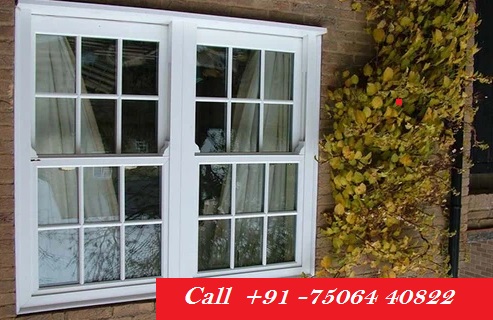Bay windows extend outward from a building’s main walls, forming a bay in the room. They typically consist of a central window and two side windows, which can be set at various angles. UPVC bay windows offer durability, low maintenance, and excellent insulation. Here’s a comprehensive guide to designing and servicing bay UPVC windows:

1. Determine the Window Dimensions and Configuration
- Measure the Opening: Measure the width, height, and depth of the bay to ensure the window fits perfectly.
- Configuration: Decide on the number of windows and their arrangement. Common configurations include a large central fixed window with two smaller operable side windows (e.g., casement or double-hung).
2. Frame Style Selection
- Frame Profile: Choose a frame profile that complements the architectural style of the building. Options include chamfered, sculptured, or flush profiles.
- Color and Finish: UPVC frames come in various colors and finishes, such as white, grey, brown, and wood grain.
3. Glazing Options
- Single or Double Glazing: Double glazing is preferred for better insulation and noise reduction. Triple glazing can be used for even higher energy efficiency.
- Glass Type: Options include clear glass, tinted glass, laminated glass, and low-emissivity (Low-E) glass for improved thermal performance.
4. Energy Efficiency
- Thermal Insulation: Look for windows with high energy ratings. UPVC is a good insulator, and when combined with appropriate glazing, it enhances thermal performance.
- Seals and Gaskets: Ensure high-quality seals and gaskets to prevent air leakage and improve energy efficiency.
5. Hardware and Operation
- Hinges and Arms: Use corrosion-resistant hinges and arms for durability. Stainless steel or high-quality coated metals are recommended.
- Handles and Locks: Choose easy-to-operate handles and secure locking mechanisms to ensure safety and ease of use.
6. Ventilation and Weatherproofing
- Ventilation Control: Incorporate operable side windows (casement, double-hung, or awning) to provide ventilation.
- Weather Stripping: Incorporate effective weather stripping to prevent water ingress during rain.
7. Security Features
- Reinforced Frames: Ensure the UPVC frame is reinforced with galvanized steel for added strength and security.
- Secure Locking Mechanisms: Use robust locking systems to enhance security and prevent unauthorized access.
8. Aesthetic and Design Features
- Mullions and Transoms: Incorporate mullions (vertical bars) and transoms (horizontal bars) for a traditional look.
- Decorative Elements: Consider adding Georgian bars or leaded lights for a classic appearance.
- Bay Window Seat: Design a bay window seat with storage beneath for added functionality and aesthetic appeal.
9. Compliance and Certification
- Building Regulations: Ensure the design complies with local building regulations and standards for safety, energy efficiency, and performance.
- Certifications: Look for windows with relevant certifications, such as CE marking, indicating compliance with European standards, or other local certifications.
Example Designs
Basic Bay UPVC Window
- Dimensions: 2400mm width, 1500mm height, 600mm depth
- Frame Profile: Chamfered, white finish
- Glazing: Double glazed, clear Low-E glass
- Configuration: Fixed central window, two operable casement side windows
- Security: Reinforced frame, secure locking system
Decorative Bay UPVC Window
- Dimensions: 3000mm width, 1800mm height, 750mm depth
- Frame Profile: Sculptured, wood grain finish
- Glazing: Triple glazed, tinted glass
- Configuration: Fixed central window, two operable awning side windows
- Aesthetic Elements: Georgian bars, bay window seat with storage
- Security: Reinforced frame, advanced locking system
